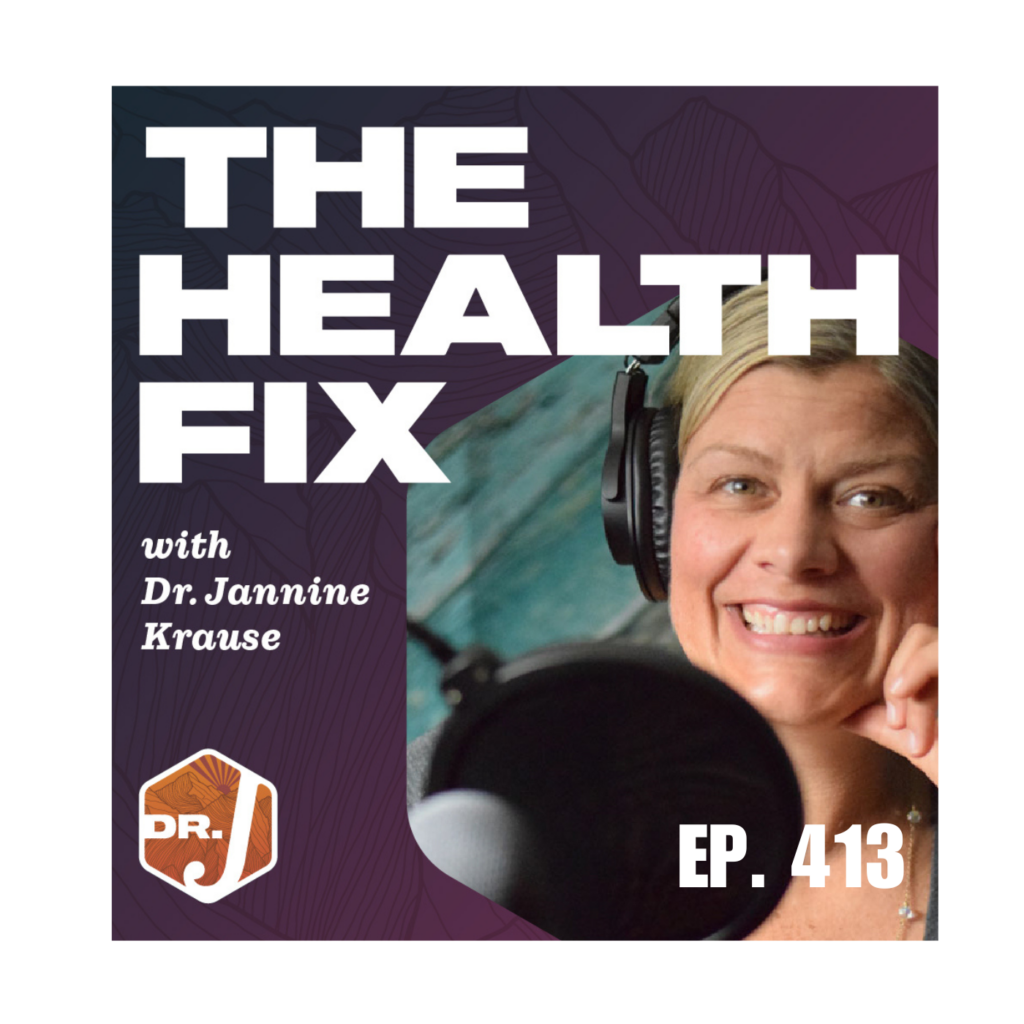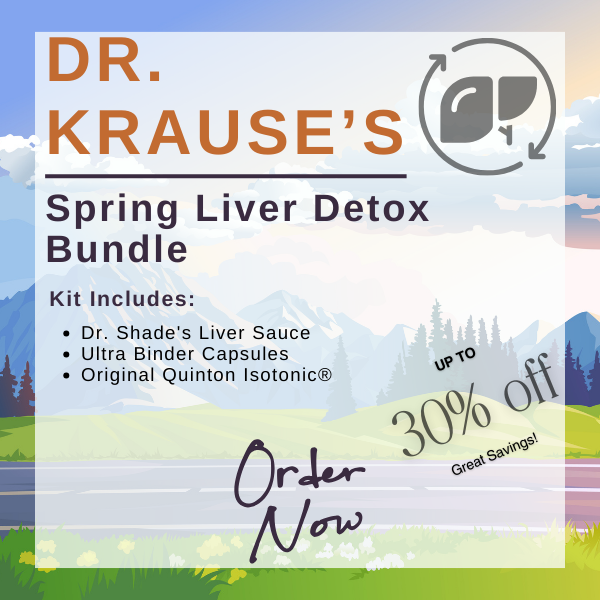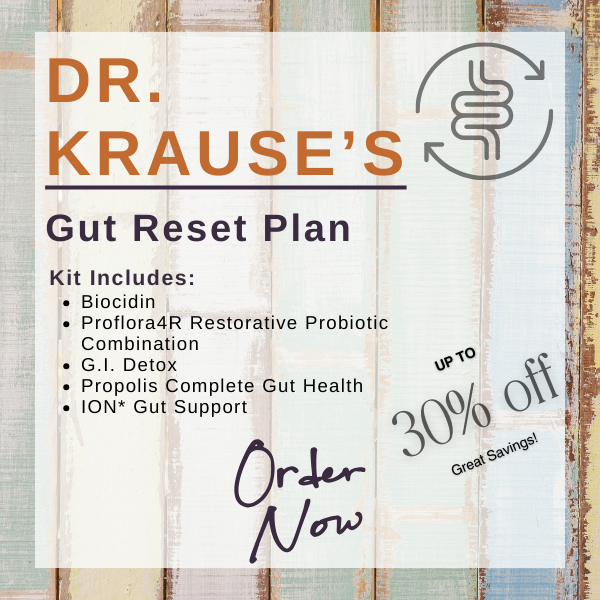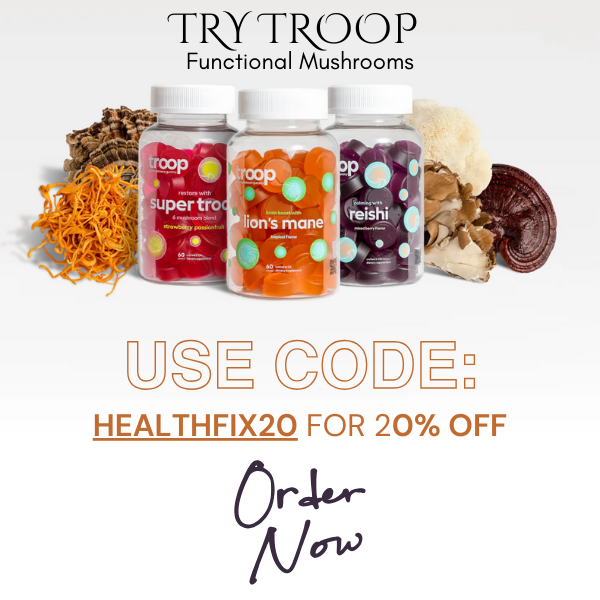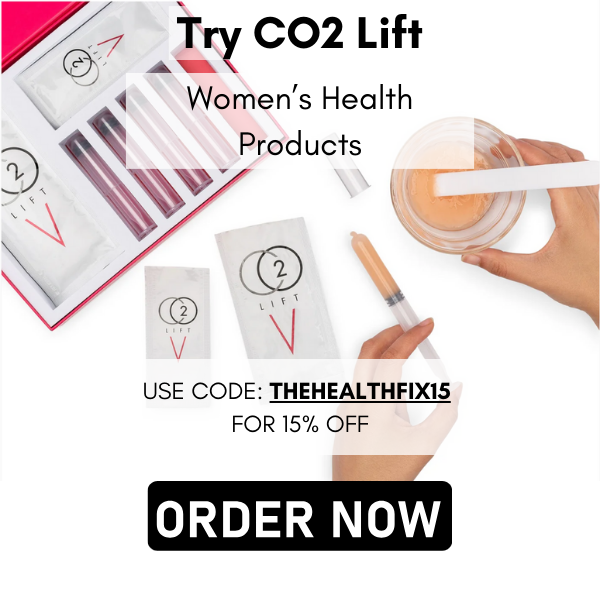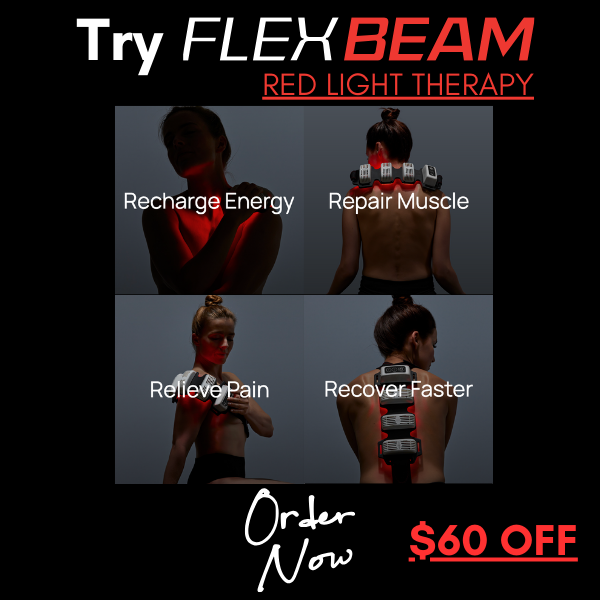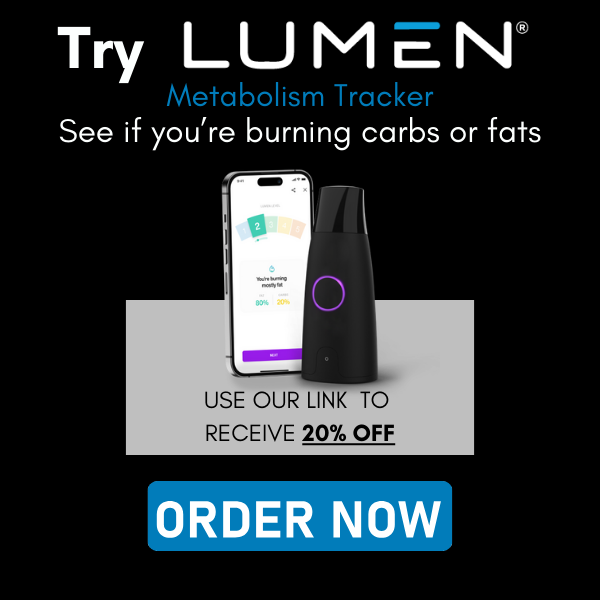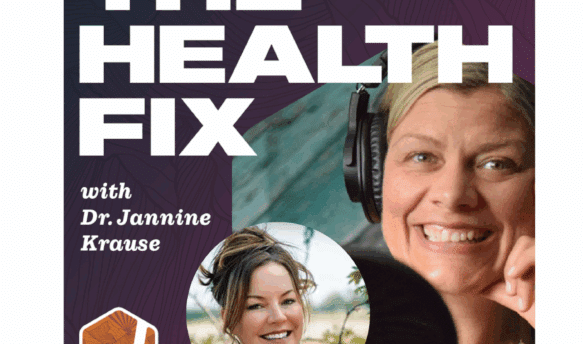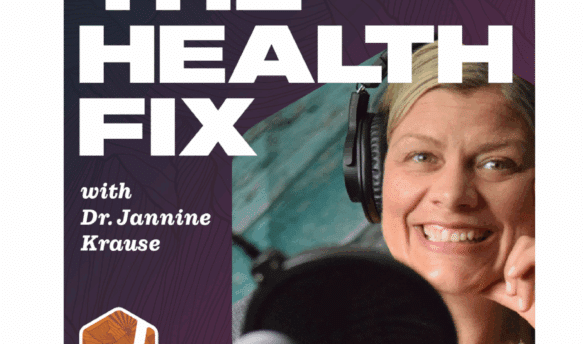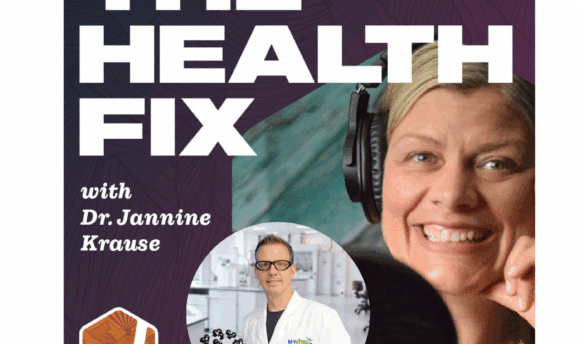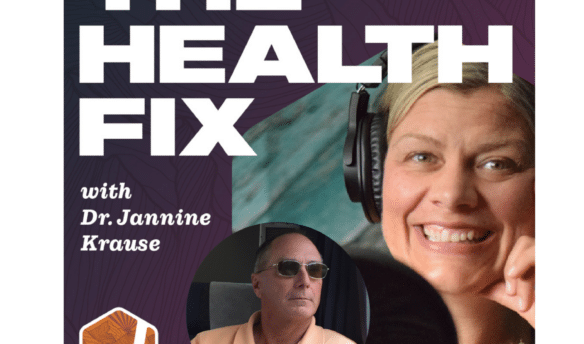Have you thought about dabbling in biohacking or even functional medcine but heard that the supplement protocols and lab testing were incredibly expensive? Perhaps you’ve tried different doctor’s or health professional’s protocols for certain conditions and were left thinking, what’s next? I’ve always thought that everyone has the potential to become their own best health guru. In this episode, part 1 in a 2 part series of The Health Fix podcast I, Dr. Jannine Krause, go through what it takes to set the foundation to create your own protocol to optimize your health.
Dr. Krause’s Protocols
Instructions Included
Traveling soon? Looking to detox or reset your gut? Try one of Dr. Krause’s Fullscript plans.
What You’ll Learn In This Episode:
- The importance of setting health and adventure goals
- What health metrics to track and when
- Functional medicine testing and how to know what’s right for you
- The power using health tech sparingly to get the most data
Resources From The Show:
- Dr. J’s PDF guide: “Steps to Become The Master of Your Health”
- Open to working with Dr. J as your guide? Bonus for podcast listeners – complimentary calls to see if & how Dr. J can guide you – click HERE
Our Partners
Podcast Transcript
JANNINE: Welcome to the Health Fix Podcast where health junkies get their weekly fix of tips, tools and techniques to have limitless energy, sharp minds and fit physics or life. Hey health junkies on this episode of the HealthFix Podcast, you get me, Dr. Jannine Krause. I’m going to be doing a two part series where I’m going to talk through what I’m seeing as the most beneficial way to optimize your health, but also not only that, improve your longevity, improve your physical performance at any age, even if your hormones, your energy levels, your aches and pains are getting in the way. So today I’m going to be going into a step-by-step philosophy of sorts as to how I’m working with folks and getting the best results. With the premise being that I don’t want anyone to follow someone else’s protocol or gurus, this works for me so it must work for you kind of concept. If you get annoyed by those things, you’re in the right place. If you’re a rebel and you’re like, “Wait, what about me? I’m unique. You’re in the right place.” What I intend to do in this podcast is to go through in two parts what I’ve been working with with folks and getting the best results and something that really is solid, it’s sustainable, it’s not just a, “Hey, here’s how we’re going to bounce your hormones and then what?” Or here, let’s work on your PCOS or here, let’s work on your fatigue. But then what? What about the rest of you? What about optimizing longevity? How long do you want to live? Do you want to live? Well, I hope so. You’re probably listening to this because you do. But also, what are your health goals in your adventure goals? Like what do you want to do when you’re 80, 90? What does 120 look like? Yes. I am absolutely putting it out there. So the idea that I want you to be thinking about throughout this podcast is what do I see for myself as I get older? Do you want to be doing really cool stuff to the day you die? I hope so. What kind of things do you want to do? Who do you want to be doing them with? And what do we need to do to make sure we keep your brain and your body healthy? For life. That’s what I want you to start thinking about. So let’s get into the podcast.
Hey, health junkies. So let’s dive into this one. I want you to be thinking like I mentioned before about your adventure goals. You’re like bucket list. If you could do anything, what would it be? And write all those things down. And of course, if you’re walking, working out, whatever it is right now, just keep a mental list of them. You know what they are. You always kind of had that in the back of a mind of like, “I would be really cool if” or wouldn’t that be really amazing if? So let’s dive into this a little bit more. Because to be able to have goals and health adventure goals and adventure goals and fitness goals and whatever it may be, maybe it’s travel. Maybe it’s adventure travel. Maybe you want to hike like Mount Kilimanjaro. Maybe you’re one of those people that sees all those folks on Mount Everest and you’re like, “That looks like fun.” Hey, whatever floats your boat, I’m here to help. Now here’s the thing. Most of us have been conditioned to give our power over when it comes to our health to someone else, to a doctor, to a guru. We follow protocols. And if you’re like me you might try to follow them to the tee. And you know, if you were an overachiever in school, then by golly, you’re going to overachieve on protocols. And then things don’t necessarily work out. They can be really freaking disappointing. So how do we make sure that what we’re doing gives us clarity and confidence that we are doing the best thing for our health? Well we need a trajectory. We need a direction. And the best place to go with that is to start with where do you want to go? A lot of people talk about reverse engineering your goals. Health is the same way. So are your adventures, your bucket lists, everything. What do you want to be doing at 120, 130, 150 years of age? I know. I’m saying things crazy, but here’s the thing. We have potential. We have a lot of potential. And part of what the problem is is we’ve got our head in the way and we’ll talk about that a little bit later. But right now, we’ve got to have a goal. We’ve got to know where we’re going. And one of the biggest things that gets in the way of anyone’s health journey is they will go into a doc and have a complaint, a symptom. And they’ll be like, “Doc, I really want to get rid of this hip pain. I really want to get rid of my gut issues. I really want to get rid of these headaches.” But that’s all is said. We don’t talk about like why do you want to get rid of these headaches? What are they interfering with? Like yes, they interfere with life, yes, they get in the way. But if you could have these headaches gone. If you could have that pain gone. If you could have the fatigue gone. If you could get the hot flushes, the night sweats, the hormones, the mood swings under control, the insomnia unchecked. What could you achieve? What do you want to achieve? What does getting older look like for you? What will you be doing? What could you be doing? All of these questions are things you really want to spend time on. You want to categorize them. You want to put down like what are your fitness goals? Please don’t put down weight loss for the love of God. No one at their deathbed is ever like I really wish that I lost those extra 20 pounds. It’s about the experience. So let’s look at like what do we want to be fit for? What do we want a spelt body for? What do we want to be strong for? What do we want to be mentally capable for? We want to be thinking about these. And we want to be thinking about what we definitely are not headed towards in life. We don’t want. Now, I don’t want you right down what you don’t want because we don’t want to call in any of that energy you do. But I want you to be thinking about what do you want? You see in the movie the notebook? The notebook? Yeah. What do you want? That. What do you want? Write it all down. Put it out in big detail and freaking dream. Unfortunately in life, and this is something that’s happened to me and I’ve called myself out on it is that I stopped dreaming at some point. Probably right around the age of 10, once I started to be told that my ideas were crazy or I was absurd. Something. Whatever your issue is, that’s okay. Something happened. But I want you to dream big because here’s the thing. If you think of yourself in a wheelchair, a nursing home, an assisted living, having aches and pains, not being able to do what you want, well, you’re going to get just that. So the idea here is dream big, write it down and write down those goals because when you know what your adventure goals are and what your health goals are and why you want them, now you can build your own program around these goals because you’re targeting to what you want to do. Not the guru that’s like, hey, I’m going to help you get through menopause. Great. What about like when you get to 80? What’s going on with that? Your hormones change. Things change. So the idea here is thinking about where am I headed, what’s my adventure goals, what’s my sport goals, what’s my fitness goals, what’s my health goals, why do I want these goals, what do I want to be able to do? And then we’re going to talk about what you need to do to track, what behaviors you need to assess because habits, routines, behaviors, and beliefs all are in play here. They can mess you up or they can help you out. We’re going to work to help you to get them to help you out. So write down your goals, write down what you’re looking at in terms of like I said, adventure goals too, but what you’re looking at in terms of what you want to do when you get older, what do you want it to be like? How do you want to interact with people, where you want to live, break it down, all the details, dream big, do it up because once we know where you’re headed and we know what you want and we know how these symptoms that you experience right now are in the way, now we know what to track and how to adjust things going forward. So that being said, once we know what the goals are, now we can look at metrics and metrics really tie back into one, yes, what symptoms you have going on, but also where you’re headed. So for example, if right now you’re having aches and pains, maybe you’re having hot flashes, maybe you’re having night sweats, one of the biggest things there is circulation and dehydration is another factor. A lot of people aren’t great at drinking water, but then there’s also the other category of we start drinking water and we forget electrolytes. So one of the metrics you might want to be thinking about is like, okay, maybe I need to track how much water I’m drinking and getting in electrolytes after my workouts or after my physical activity or after a mentally taxing day. That folks crucial. And that’s one of the things that I learned from tracking how I felt every day. So going into the metrics and what to track and how to know what’s worth it for you is to look at one, your symptoms like I had mentioned before, but two, how are your symptoms interfere with your day and when they show up? So what am I getting at here? A daily journal on health. It does not have to be anything ridiculous. In fact, you could even do a weekly one with a monthly summary. That resonates more with you. Great. Forget, you know you forget to do it. Put a reminder in your phone on your computer so that you have a little bell that tells you to do it. There are so many things these days that can completely help us. Now I wouldn’t get hung up on getting a fancy journal even though there are some amazing ones out there, no doubt. I actually chart everything on an old school calendar, usually one that I got for free from somewhere. If you have access to that, that is a great place to start. Over time, you might decide to tweak it a little bit. Now I also track in my app that I use for my temperatures.
So let’s talk about targeting in what to really track because I think for a lot of people, it is confusing. We don’t know like what should we be tracking, what should we be looking at. This is where folks like myself come in as great guides to help you narrow it down but of course within this podcast, I want to give you some ideas. Now hydration electrolytes, huge, minerals, huge. These are key things that we tend to blow through but also we don’t get enough of within our diets. When I talk about minerals, I’m talking about magnesium, I’m talking about selenium, copper, zinc, those kind of things. What is the best way to get minerals in? Honestly, a liquid type of mineral. There’s a company called upgraded formulas. I like their liquid minerals. They’re nice, easy to drop style, put under tongue. Well, actually got to put in water then put under tongue and then you’re done. Boom. Definitely want to have some food in your stomach though if you’re going to do minerals. Just tidbit if you ever had zinc or even magnesium on an empty stomach and sometimes cause some stomach upset. The reason being is you need stomach acid to be able to break them down and get them into your bloodstream. Something to think about, if you ever had any issues with minerals. Now the other cool thing is there’s a lot of companies out there who are creating electrolyte drinks with minerals. How cool is that? There’s one called Goodonyaorganic.com. I really like them. They’ve got some cool creative products. I get no money from them whatsoever. I just like their product. So that being said, we’ve covered hydration electrolytes and a lot of people might be rolling their eyes right now and being like, “Yeah, duh.” Okay, great. Let’s move on to things that are a little bit more not so duh. Sleep. Definitely. Good to track. Good to know what jacks with your sleep. The sleep is the ultimate recovery tool. You can take copious amounts of melatonin and you can take althenein and you can take holy basil ashwagandha. I could go on for days about certain things you could take, progesterone. But if you’re not solidly sleeping and you don’t have a good wind down routine, you’re going to have trouble sleeping and recovering fully. Food makes a huge impact on how you sleep, different types of food, carbs versus proteins, all to have a factor. So making notes of sleep is an issue for you, making notes around what’s happening in those three to four hours before bed. How do you shut down your day from work? Do you have a hard stop on work or do you just keep going and going and you’re on that email until it’s time to go to bed? If you don’t recommend it. You’ve all heard about the blue light blocking glasses and all those things, but the reality here is it’s incredibly important to set a wind down routine. So that’s a metric. Did you do your wind down routine? Now if we’re looking at another really important factor, it’s breath, it’s relax, it’s sleep, and the other big one is movement. And so when I talk about movement and relaxing, you might be thinking like, what the heck is she talking about? Here’s the thing, we need brain breaks during the day. We do. Sleep is like our ultimate brain break, but we need little timeouts. So this is another metric, especially if you live a fast-paced life, you tend to become stressed pretty easy if you’re having anxiety, insomnia, of course, and if you’re struggling with hormones, stress can be a huge factor. Every single person that works in the US at least is entitled to 15 minute breaks for every four hours of work. Funny how only the smokers take those breaks. I’m going to encourage folks, even if it’s two minutes to get a brain break. And in that brain break time, maybe you’re working on some breath work, maybe you explore breath work a little bit more, maybe looking to Wim Hof stuff, maybe you look into oxygen advantage stuff. I’m happy to answer questions on that with anyone. I love the breath work, but I also love movement. And in my brain breaks during the day, I will take walks. I will do hula hoop. I will get out in the garden when it’s appropriate in that season, or I will get out and play with my dog. The point being, is that’s another metric that you could be looking at, especially if you’re stressed. And the other side of that is looking at what provokes your stress. What gets you fired up? What gets you agitated? Do certain foods make you aggro? Do certain situations, people, beliefs? What is it? Start journaling on this. These are important things to understand because nobody I know of in their 90s is like, I really want to be stressed by the time I’m well into my 90s. No, you want to be chill, you want to be able to be like that. Chill guru. Just be like, yeah, I got this. And your great grandkids or whoever that comes by, they want to hang out with you because you’re not grumpy. So that’s one thing. The other metrics are more fitness kind of movement related in terms of mobility, in terms of your cardiovascular capabilities, in terms of your strength capabilities. Since I was about 15, I have been kind of tracking my strength, bench press squad, lunges, how much weight can I do with lunges? All the things, biceps, triceps, you name it. I didn’t ever have a goal though. You know what? I was just tracking it because I wanted to make sure I was improving. But now as I get older, I want to make sure I’m improving and not declining. And I want to make sure that I’m improving without pain, without injury, and my mobility is not compromised. I think mobility metrics are huge knowing how well your ankles move, your toes move, your knees move, your hips move, your back, like your whole spine, arm shoulders, fingers, toes, you name it. Neck, jaw. All these things are important because the better you move your joints, the better you’re going to be with whatever adventure. Say you want to hike, say you want to bike. What needs to be strong to do that? Balance, agility. Say you want to climb 14ers in Colorado and you know that there are rocks on the top, like scree, and there’s also things you got to scramble over. And you want to do that in your 80s. Okay. Time to do some crawling work. So using these goals of what you need to do and practicing it, I intend to keep crawling and doing bear crawls and things of that nature as long as I freaking can. And here’s the thing, I intend to do it today. I die. Now that might sound absolutely bizarre, but we’ve all been freaking brainwashed about getting older. And oftentimes I hear it coming out of my friends, my family’s mouths, and even my own, they go, “Oh, I don’t know if I’m going to be able to do that when I’m older.” Oh, I haven’t done that for a while. I don’t know if I can do that. Like, what? If you say these things, what do you think is going to happen? Now I know a lot of people listening to this right now are going to be like, “She is batty. There’s no way that into your 80s, 90s, 100s you can keep doing stuff.” Well, have you seen a lot of the people on social media or blue zones or any of those? Yeah. There’s some people who are older doing incredible things and we need to share more of that. Because I unfortunately feel like the more of what we see is folks declining, folks hobbling around, folks using walkers, folks using canes, folks using wheelchairs. For the love of God my uncle heard us back, he’s 70 years old and he crawled up my dad’s stairs to get to our house. And I’m looking at him going, “Oh my God.” One, he was coming to see me for acupuncture. Don’t worry, he didn’t crawl on the way out, but I don’t want to be crawling like that. I want it to be like a fitness thing, not a, I am in pain and I have to crawl upstairs. This is stuff that we see every day with our family members, relatives and it does mar our vision of what we have in terms of potential for the future. But I want you all to imagine the concept of delusional optimism right now. And why do you might think I’m delusional? That’s cool. The idea here is if you know where you’re going and you know what you want to be doing, maybe you want to be playing pickleball, maybe you want to be playing tennis golfing in some amazing areas. A lot of times you’ll see folks sitting on those golf carts and when they get out of the golf cart they are barely able to walk. I don’t want to be that person. I get mad when I go to golf courses and they’re like you have to have a cart. I’m like what the heck are you talking about? What if I want to walk? They’re like well mam, you need a cart. I don’t want to go to this place. I want to walk. And here’s the reason. Because I want to be able to do that plus I like walking with my golf clubs. I don’t know. But here’s the thing. We all have our visions for what we want our future to be like. Unfortunately we’ve seen a lot of things of what the worst case scenario is. You can look at your grandma, your grandparents. I mean just look at TV for that matter. All the fallen I can’t get up commercials. I mean my god if you watch TV in the middle of the day or you watch grit because if you’ve ever seen Grit my dad loves to watch all those old westerns but all the commercials are Medicare commercials and depressing and the fallen I can’t get up business and the this and the that. Now. So this is my plea to all of you. Get your goal set up. Know what you want to do in the future. Write down all the adventures and what does it take to get there. So I’ve talked about metrics in terms of strength. So noting what your push up amount is. How long can you hold a plank? How far can you walk without getting tired? How far can you run? In 11 minutes. These are actual tests that you can perform on yourself every four weeks. So let me recap that. How far can you walk or run in 11 minutes? How many push ups can you do after you get done with your walk or run? How many push ups can you do consistently without stopping? Then how long can you hold a plank? A front plank? A side plank and another side plank. Write those down every four weeks. That is a great metric to let you know where you’re at. That’s a great place to start. And if you’re working with a coach, as a conditioning coach, like myself or anyone else out there, you can mix it up as to what kind of different activities you can do. But first and foremost, you got to track things and you got to know where you’re starting and where you’re headed. So that’s one thing. Another thing is looking at your blood pressure. Looking at your heart rate. These are two great, fascinating and really helpful metrics to know what’s happening cardiovascular-wise. In particular, your heart rate. Having a good handle on your resting heart rate, so that’s your heart rate before you get out of bed every single morning, take it for five to seven days in a row and get your average. Then watch it. If it goes up, that means you didn’t recover from the day before. Whether it was mental stress, whether it was physical stress, something got you. Maybe food stress too. Sometimes we eat things in the body, doesn’t get along with it. Alcohol can do it too. But you want to watch that. Because that kind of stuff can be fascinating to give you some really good insight into how to tweak your workouts, how to tweak what’s going on with food, how to tweak what’s going on with stress too. It can call you out faster than anything else. Now the next advanced level from that is heart rate variability, HRV. You can track that with apple watches. You can track it with Whoop. You can track it with Garmin. You don’t want to track it every single day. You want to track the trajectory. So the month trajectory. If you’re moving upwards, you’re doing good. Day to day, you’ll get thrown off and it’ll mess with you. But your heart rate, you can look at that day to day and see what’s going on. So those are some metrics for cardiovascular capability that are huge. Other metrics like I mentioned were the mobility metrics. These are incredibly important knowing how while your shoulders move, knowing how while your wrist moves, your elbow moves, your fingers move, your toes. Every joint you have, if there’s a hang up, it’s time to learn what you can do like gau sha, which is a little scraping technique. Capping, you can do cupping at home. You can do massage, self massage. There are a lot of things you can do. You can go to acupuncture, you can go to massage. There are lots of mobility kind of like ball kind of things where you can release the areas. There are things called yoga balls, [inaudible]. So many options nowadays. It’s incredible. But working on mobility and finding out if your mobility has some weakness to the joint stability, anything going on there, I highly recommend for everyone to go to a functional movement specialist or even a physical therapist that focuses in functional movement head to toe. Not just the PT that’s going to look at your elbow or your ankle because you heard it. You want the PT that’s going to do head to toe kind of stuff, specialized PT’s. Knowing how well you move, investing a couple hundred bucks and having someone look at you is priceless. Because if you’ve got hang ups now, you better believe if you don’t do anything, those hang ups are going to get worse. And the number one thing that hangs up people, as they get older, mobility and then nerves start to have issues. So now this is where we come into balance and metrics with balance. Now I’m spitting off a whole bunch of different metrics and you might be thinking, oh my gosh, how could I even keep up with all these things? I got you. I don’t do this every day. It’s more like a monthly check in thing to know where you’re at. How is your balance balance and coordination are huge. That’s what keeps you from having to have a cane, a walker, getting in a wheelchair, that kind of stuff. Balance is incredibly huge. So thinking about how to incorporate all of these in, like I said, monthly kind of check-ins would be things like balance, things like checking in on your mobility. Once a year doing a head-to-toe check on mobility, maybe even twice a year, depending on how adventurous you feel, I mean some people I know do it quarterly. That’s up to you. If you’re training actively to run an Iron Man or do a triathlon or something like that, but I don’t mean to just probably do it more frequently. So these are important to look through. Now have I covered every single thing you could possibly look through? No. Temperatures another one. Temperature is something that I have folks who are of peri-menopausal or pre-menopausal age, meaning you still get your period. If you’re still getting your period, looking at your temperature can give you a lot of insight into what’s going on in your cycle. I use the temp drop app for that and the temp drop device. It measures your temperature at night. Now food, that’s another metric that a lot of people, I think, spend way too much time. In fact, I probably could have a PhD in macros for how much time I spent on that. If you’re really struggling with metabolism, it’s worth getting to know how your body responds to food. Doing a continuous glucose monitor and having a program like levels, it’s a membership program with the continuous glucose monitors, or doing something like Lumen, which is the carbon dioxide sensing breath device. I’ll have links for all of these in my podcast notes so you guys can get discounts if you want to do any of these. But the point being is with Lumen, I have used that and I do use it right now. I’ve used it in my group programs too. In that, it helps quite a bit for you to understand how certain foods, certain food combos affect you and what happens with your fat and card burn. You can gain a lot of insight. I’ve even had people pair their continuous glucose monitors with Lumen to determine their full picture of what’s going on with their food and how things affect them. But if food is not necessarily an issue for you, then don’t spend time tracking that. If you feel like you have gut issues, that’s where you want to track and see what kind of things might be going on. More often than not, gut issues as we get older have to do with declining enzymes. Maybe some of these are overgrowth of bugs, but it’s the process of eating. Another metric you could check would be, did you sit down and chew your food? Sounds insane, but I could tell you, I don’t even know why for so many years I had a kitchen table when I would stand at the kitchen sink and eat. Things to think about. So here are other metrics. Now another really big one is mental health and cognitive types of metrics. I definitely wouldn’t want to live a long life if my brain wasn’t there. So how do you track your metrics on your brain? You can do certain brain games. A lot of people do so. Sodoku, there’s so much out there. There’s a ton of apps with brain games. There’s many things you can do and that would be a metric to check that you did that each day and then at the end of the month seeing if you’ve improved in your scores. Huge, huge stuff. I highly recommend some brain games. Now the other big thing is looking at internal systems health. And those metrics are, I like to put them in a category of their own in terms of testing and testing metrics. When it comes to the ultimate metrics of testing, you know, things like the old standard complete metabolic panel, which is the check in on your liver and kidney function. So it looks at blood sugar, it looks at proteins, it looks at carbon dioxide levels. This monitor is like a super cheap way to know, are my kidneys doing okay? What’s going on with my creatinine? And I, you know, doing okay in terms of liver enzymes. Are there too many popping off? Is my kidney function good? Like my glomerular filtration? I know what the heck is that? That is G. It looks like EGFR on your comprehensive metabolic panel. And the higher number on your EGFR, the healthier your kidneys are. Over 80 is good. Over 90 is excellent. I want folks to be striving for looking at that in their labs. Now another big thing is looking at your complete blood count, your red blood cells, your white blood cells. How are those guys doing? Having abnormals in this department can really clue into certain things. If you have low white blood cells, consistently, there’s something going on in terms of your immune system being underactive. If you have high white blood cells, now we have an overactive immune system. You could look down even into the breakdowns of the white blood cells, such as the neutrophils, the lymphocytes, and the monocytes. In a normal situation, the neutrophils should be the highest, the lymphocytes second, and the monocytes last. If the neutrophils are lower and let’s say your lymphocytes are higher than your neutrophils, now we’ve got the body cleaning up a mess. Question is, what is it? You’ve got to go back and go to some food poisoning. Did I get sick while back? What’s happening? If the monocytes are higher, now you’re looking at, hmm, did I get a virus? Is mono-reactivated in my system? You can retest labs to look at reactivated mono and seeing if that’s a thing for you. Maybe you just need a little bit more anti-viral herbs. Here’s the thing, knowing what’s a trend for you, because there are a lot of people who tend to go lower on their white blood cells. That’s just them. Knowing that is huge. Now also being able to catch things like your liver and enzymes going up. Your blood sugar, like glucose, fasting glucose going up. Himoglobin A1c, this is your blood sugar over time. That can give you a really good metric as what’s happening with your blood sugar. The reactive protein, it’s a flammatory protein that comes from your liver, what’s going on with that, because that’s also linked to cardiovascular inflammation. Knowing your cholesterol numbers, but in particular, you’re trying glycerides, because that’s your carb going to fat. Also talks about what’s going on with your blood sugar management as well. Vitamin B12, folate, looking at your full thyroid. That tells about your metabolism. Your TSH, your free T3, your free T4, T3 uptake, your antibodies to your thyroid to see if you got any of those. There’s a lot we could be looking at that are basic metrics. Now I will have a PDF available so that you can see what my basic tests lists are, because this would be like an eight-hour presentation if I went through everything. Now some other metrics that you might be wanting to look at are something known as organic acids tests. Like acids tests are urine tests that tell what’s going on in the body in terms of vitamin and mineral deficiencies, in terms of what’s going on with how you process fats, proteins, carbs, but also they look at any bugs that might be in your small intestine, like yeast overgrowth or bacterial overgrowth. Some of these are really cool for you to be able to see the state of your body. The tests I’m talking about for organic tests that I like the best is something called the Metabolomix. It will tell you if you have too much oxidative stress, if your mitochondria are struggling and mitochondria are something you want to keep healthy as you get older. That is like the crux of your metabolism, but also the crux of your health and longevity. If your low factories and all your cells are not making energy well, you could be the fittest person on earth, you could be the fastest, you could be the most mobile, most cognitively on point, but if those little mitochondria aren’t doing their thing, you’re going to have some trouble eventually. It’s going to catch up with you. Having your metrics on your Metabolomix, huge. Another thing there is looking at gut, if you have gut issues, that might be a metric to look at and see how your gut’s doing. If you are dealing with hormone stuff, and I highly recommend anyone who’s over 40 to do at least once a year checking on saliva hormones or urine hormones, just a new year at, you could do blood too. If you’re using a topical bio-identical cream, you want to use saliva. If you’re using injectable, you could use blood or urine test capsules. You can look urine too. BioT, you could also look urine. Here’s the thing. Hormones are huge. You want to do a check in at least once a year on that. A lot of folks ask me, “We’ll talk. What about metrics on my DNA testing?” One and done on DNA. One and done. Then you know what’s going on. Do I use it? Yes. Do I think that we have to have multiple tests, like I said? No. One and done on DNA. What about testing for looking at things like what’s happening in terms of specific cardiovascular stuff? Absolutely. If you’re having high cholesterol issues, yes. We do want to go into that and know what’s going on. Boston Heart Labs has some great stuff. What about food sensitivities? You can learn a lot more if you do a stool test and if you do more or less an elimination reset kind of plan, which could be another metric for you to know if you pull out all the inflammatory foods and you put them back in one by one, what kind of thing affects you? Delimination diet is hands down the best way on understanding what’s going on with your gut. Hands down. Now, what about heavy metals? What about chronic infections? Things of that nature. These are some metrics you can definitely check. If you notice that you’ve been struggling with chronic fatigue, maybe you’ve been exposed to mold, maybe you’ve been exposed to heavy metals, which is pretty much everybody. How’s your liver function? If you’re noticing issues with your liver and you’re like, I don’t drink, I don’t eat clean, you want to look and see what the heck’s going on. Now diving in deep for different types of bacteria, different types of things that may be causing autoimmune fatigue, kind of conditions or random, weird chronic inflammation, blah, I call it that super technical. I would be looking at something called a Pyrex Array 12. So Cyrex array 12 would be what I’d be looking at department. These are metrics that you can be doing one and done and know what’s up or the regular ones like the complete metabolic panel, your CBC, your cholesterol inflammation markers. That’s something I would do at least twice a year. In terms of stool testing, I would probably do that at least twice a year on those folks that are having specific gut issues, just to make sure that things are better. You know, do at least a before and after. Now the OMX or I call the OMX, that’s the O test, which is organic acids. There’s something called the OMX, but I like the Metabolomix spatter. OMX tests, I have folks do them twice a year to start and then once a year just to know on your metrics of your overall health. And like I mentioned before, DNA, that’s one and done. So you know what’s going on. And if there’s anything that you’re specifically wanting to see if you’re making some change like hormones, you might want to consider hormone testing quarterly and then break it out to twice a year and break it out to once a year to know where things are at once. You’ve figured out if you’re going to use bio-identical hormones or use herbs to intervene. So lots of different ways that you could look at the testing metrics, but this stuff is huge. And not just doing one and done on certain ones, you want to know like if your interventions worked, so keep that in mind. I will have some details in terms of a PDF for you to be able to check that out. And definitely being able to check that out in the podcast notes at doctorjkrausend.com. Now I talked a ton about labs and there are so many of them out there that you could go after. But really you want to keep in mind and keep focusing on your goal. What are you trying to achieve, right? Are you really tracking certain symptoms that you want to optimize? That’s where you want to keep yourself in check because these tests are expensive. You don’t need all of them and really the complete metabolic panel and the CBC can get you a lot of info along with the couple inflammation markers and go a long way with those just to get started. But if you have certain things like gut issues, you do want to consider stool testing. If you have fatigue issues, recovery issues, just not feeling as strong as you once were, you do want to look at organic acids test. And if you’re having chronic fatigue and it’s coming out of nowhere and you’re like, I have no idea what this is. Maybe you do want to look at a Cyrex Array 12 to see what could be going on there as like a chronic autoimmune, immune system reaction kind of thing. And then last but not least, definitely not least is the hormones. And if you’re already supplementing with bioidenticals, depending on your delivery method, if it’s topical saliva will give you a lot of info if it’s injectable or like a bio tea, which is the pellets or oral blood or urine will give you some pretty good info. They’re same with herbs. And some looking at your hormones regularly at first until you’ve got it pretty dialed in and then at least once a year from there on out. So we’ve talked about a lot just in this first half with looking at your health goals, knowing what adventure goals you have, what metrics we need to look at. And then I went into of course now all the testing. It’s a lot of stuff. I hope I didn’t overwhelm you guys too much. So I’m going to cut this podcast off here and move into the second half later so that we can kind of let you digest all of this. And then second half, I’m going to be talking about mobility. I’m going to be talking about circulation. I’m going to be talking about conditioning training and beliefs. A lot of the mindset that has a lot to do with how to move yourself forward in this department. So all right, go over to doctorjkrausend.com for more information, my PDF handouts for you, and let’s see you in part two.
[Outro] Hey fellow health junkie, thanks for listening to the HealthFix podcast. If you enjoyed tuning in, please help support me to get the word out about the podcast. Subscribe, rate, and review, and just get that word out. Thanks again for listening. (upbeat music)
